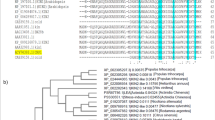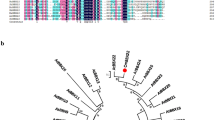Abstract
We previously reported that one of the brassinosteroidinsensitive mutants, bri1-9, showed increased cold tolerance compared with both wild type and BRI1-overexpressing transgenic plants, despite its severe growth retardation. This increased tolerance in bri1-9 resulted from the constitutively high expression of stress-inducible genes under normal conditions. In this report, we focused on the genes encoding class III plant peroxidases (AtPrxs) because we found that, compared with wild type, bri1-9 plants contain higher levels of reactive oxygen species (ROS) that are not involved with the activation of NADPH oxidase and show an increased level of expression of a subset of genes encoding class III plant peroxidases. Treatment with a peroxidase inhibitor, salicylhydroxamic acid (SHAM), led to the reduction of cold resistance in bri1-9. Among 73 genes that encode AtPrxs in Arabidopsis, we selected four (AtPrx1, AtPrx22, AtPrx39, and AtPrx69) for further functional analyses in response to cold temperatures. T-DNA insertional knockout mutants showed increased sensitivity to cold stress as measured by leaf damage and ion leakage. In contrast, the overexpression of AtPrx22, AtPrx39, and AtPrx69 increased cold tolerance in the BRI1-GFP plants. Taken together, these results indicate that the appropriate expression of a particular subset of AtPrx genes and the resulting higher levels of ROS production are required for the cold tolerance.
Similar content being viewed by others
References
Agarwal, M., Hao, Y., Kapoor, A., Dong, C., Fujii, H., Zheng, X., and Zhu, J. (2006). A R2R3 type MYB transcription factor is involved in the cold regulation of CBF genes and in acquired freezing tolerance. J. Biol. Chem. 281, 37636–37645.
Apel, K., and Hert, H. (2004). Reactive oxygen species: metabolism, oxidative stress, and signal transduction. Annu. Rev. Plant Biol. 55, 373–399.
Brouwer, K.S., van Valen, T., Day, D.A., and Lambers, H. (1986). Hydroxamate-stimulated O2 uptake in roots of Pisum sativum and Zea mays, mediated by a peroxidase. Plant Physiol. 82, 236–240.
Burch, P.M., and Heintz, N.H. (2005). Redox-regulation of cell-cycle re-entry: cyclin D1 as a primary target for the mitogenic effects of reactive oxygen and nitrogen species. Antioxid. Redox Signal. 7, 741–751.
Cao, S., Xu, Q., Cao, Y., Qian, K., An, K., Zhu, Y., Binzeng, H., Zhao, H., and Kua, B. (2005). Loss-of function mutations in DET2 gene lead to an enhanced resistance to oxidative stress in Arabidopsis. Physiol. Plant 123, 57–66.
Chassot, S., Nawarth, C., and Metraux, J.P. (2007). Cuticular defects leads to full immunity to a major plant pathogen. Plant J. 49, 972–980.
Chinnusamy, V., Ohta, M., Kanrar, S., Lee, B., Hong, X., Agarwal, M., and Zhu, J. (2003). ICE1: a regulator of cold-induced transcriptome and freezing tolerance in Arabidopsis. Genes Dev. 17, 1043–1054.
Cosio, C., and Dunand, C. (2009). Specific functions of individual classIII peroxidases genes. J. Exp. Bot. 62, 391–408.
Dhaubhadel, S., Browning, K.S., Gallie, D.R., and Krishna, P. (2002). Brassinosteroid functions to protect the translational machinery and heat-shock protein synthesis following thermal stress. Plant J. 29, 681–691.
Edward, S.L., Raag, R., Wariishi, H., Gold, M.H., and Poulos, T.L. (1993). Crystal structure of lignin peroxidase. Proc. Natl. Acad. Sci. USA 90, 750–754.
Gilmour, S.J., Sebolt, A.M., Salazar, M.P., Everard, J.D., and Thomashow, M.F. (2000). Overexpression of the Arabidopsis CBF3 transcriptional activator mimics multiple biochemical changes associated with cold acclimation. Plant Physiol. 124, 1854–1865.
Hammond, J.P., Bennett, M.J., Bowen, H.C., Broadly, M.R., Eastwood, D.C., May, S.T., Rahn, C., Swarup, R., Woolaway, K.E., and Whote, P.J. (2003). Changes in gene expression in Arabidopsis shoot during phosphate starvation and the potential for developing smart plants. Plant Physiol. 132, 578–596.
He, R.Y., Wang, G.Y., and Wang, S.X. (1991). Effect of brassinolide on growth and chilling resistance of maize seedlings. In Brassinosteroids: Chemistry, Bioactivity and Applications, H.G. Cutler, T. Yokoda, and G. Adam, eds. (American Chemical Society, Washington DC), pp. 220–230.
Irshad, M., Canut, H., Borderies, G., Pont-Lezica, R., and Jamet, E. (2008). A new picture of cell wall protein dynamics in elongating cells of Arabidopsis thaliana: confirmed actors and newcomers. BMC Plant Biol. 8, 94.
Kang, J.G., Pyo, Y.J., Cho, J.W., and Cho, M.H. (2004). Comparative proteome analysis of differentially expressed proteins induced by K+ deficiency in Arabidopsis thaliana. Proteomics 4, 3549–3559.
Kasuga, M., Liu, Q., Miura, S., Yamaguchi-Shinozaki, K., and Shinozaki, K. (1999). Improving plant drought, salt, and freezing tolerance by gene transfer of a single stress-inducible transcription factor. Nat. Biotechnol. 17, 287–291.
Kim, S.Y., Kim, B.H., Lim, C.J., Lim, C.O., and Nam, K.H. (2010). Constitutive activation of stress-inducible genes in a brassinosteroid-insensitive 1 (bri1) mutant results in higher tolerance to cold. Physiol. Plant. 138, 191–204.
Kim, Y.H., Kim, M.D., Choi, Y.I., Park, S.C., Yun, D.J., Noh, E.W., Lee, H.S., and Kwak, S.S. (2011). Transgenic poplar expressing Arabidopsis NDPK2 enhances growth as well as oxidative stress tolerance. Plant Biotech. J. 9, 334–347.
Kinoshita, T., Caño-Delgado, A., Seto, H., Hiranuma, S., Fujioka, S., Yoshida, S., and Chory, J. (2005). Binding of brassinosteroids to the extracellular domain of plant receptor kinase BRI1. Nature 433, 167–171.
Kolk, E.J., Wilson, I.W., Wilson, D., Champman, S.C., Ewing, R.M., Somerville, S.C., Peacock, W.J., Dolferus, R., and Dennis, E.S. (2002). Expression profile analysis of the low-oxygen response in Arabidopsis root cultures. Plant Cell 14, 2481–2494.
Kumari, M., Tayor, G.J., and Deyholos, M.K. (2008). Transcriptomic responses to aluminum stress in roots of Arabidopsis thaliana. Mol. Genet. Genomics 279, 339–357.
Li, J., and Chory, J. (1997). A putative leucine-rich repeat receptor kinase involved in brassinosteroid signal transduction. Cell 90, 929–938.
Li, L., van Staden, J., and Jäger, A.K. (1998). Effects of plant growth regulators on the antioxidant system in seedlings of two maize cultivars subjected to water stress. Plant Growth Regul. 25, 81–87.
Liu, Q., Kasuga, M., Sakuma, Y., Abe, H., Miura, S., Yamaguchi-Shinozaki, K., and Shinozaki, K. (1998). Two transcription factors, DREB1 and DREB2, with an EREBP/AP2 DNA binding domain separate two cellular signal transduction pathways in drought- and low-temperature-responsive gene expression, respectively, in Arabidopsis. Plant Cell 10, 1391–1406.
Llorente, F., Lópes-Cobollo, R.M., Catalá, R., Martínes-Zapater, J., and Salinas, J. (2002). A novel cold-inducible gene from Arabidopsis, RCI3, encodes a peroxidase that constitutes a component for stress tolerance. Plant J. 32, 13–24.
Mittler, R., Vanderauwera, S., Gollery, M., and Breusengem, F.V. (2004). Reactive oxygen species gene network of plants. Trends Plant Sci. 9, 490–498.
Mohr, P.G., and Cahill, D.M. (2007). Suppression by ABA of salicylic acid and lignin accumulation and the expression of multiple genes, in Arabidopsis infected with Pseudomonas syringae pv. tomato. Funct. Integr. Genomics 7, 181–191.
Møller, I.M., and Sweetlove, L.J. (2010). ROS signaling-specificity is required. Trends Plant Sci. 15, 370–374.
Møler, I.M., Jensen, P.E., and Hansson, A. (2007). Oxidative modifications to cellular components in plants. Annu. Rev. Plant Biol. 58. 459–481.
Moon, H., Lee, B., Choi, G., Shin, D., Prasad, D.T., Lee, O., Kwak, S.S., Kim, D.H., Nam, J., Bahk, J., et al. (2003). NDP kinase 2 interacts with two oxidative stress-activated MAPKs to regulate cellular redox state and enhances multiple stress tolerance in transgenic plants. Proc. Natl. Acad. Sci. USA 100, 358–363.
Nikiforova, V., Freitag, J., Kempa, S., Adamik, M., Hesse, H., and Hoefgan, R. (2003). Transcriptome analysis of sulfur depletion on Arabidopsis thaliana: interlacing of biosynthetic pathways provides response specificity. Plant J. 33, 633–650.
Noguchi, T., Fujioka, S., Choe, S., Takatsuto, S., Yoshida, S., Tuan, H., Feldmann, K.A., and Tax, F.E. (1999). Brassinostroid-insensitive dwarf mutants of Arabidopsis accumulate brassinosteroids. Plant Physiol. 121, 743–752.
Novillo, F., Alonso, J.M., Ecker, J.R., and Salinas, J. (2004). CBF2/DREB1C is a negative regulator of CBF1/DREB1B and CBF3/DREB1A expression and plays a central role in stress tolerance in Arabidopsis. Proc. Natl. Acad. Sci. USA 101, 3985–3990.
Özdemir, F., Bor, M., Demiral, T., and Türkan, I. (2004). Effects of 24-epibrassinolide on seed germination, seedling growth, lipid peroxidation, proline content and antioxidative system of rice (Oryza sativa L.) under salinity stress. Plant Growth Regul. 42, 203–211.
Potikha, T.S., Collins, C.C., Johnson, D.I., Delmer, D.P., and Levine, A. (1999). The involvement of hydrogen peroxide in the differentiation of secondary walls in cotton fibers. Plant Physiol. 119, 849–858.
Reichheld, J.P., Vernoux, T., Lardon, F., Montagu, M.V., and Inze, D. (1999). Specific checkpoints regulate plant cell cycle progresssion in response to oxidative stress. Plant J. 17, 647–656.
Rentel, M.C., Lecourieux, D., Ouaked, F., Usher, S.L., Petersen, L., Okamoto, H., Knight, H., Peck, S.C., Grierson, C.S., Hirt, H., et al. (2004). OXI1 kinase is necessary for oxidative burst-mediated signaling in Arabidopsis. Nature 427, 858–861.
Schopfer, P., Liszkay, A., Bechtold, M., Frahry, G., and Wagner, A. (2002). Evidence that hydroxyl radicals mediate auxin-induced extension growth. Planta 214, 821–828.
Smulevich, G., Jakopitsch, C., Droghetti, E., and Obinger, C. (2006). Probing the structure and bifunctionality of catalase-peroxidase (KatG). J. Inorg, Biochem. 100, 568–585.
Swanson, S., and Gilroy, S. (2010). ROS in plant development. Physiol. Plant 138, 384–392.
Swanson, R., Clark, T., and Preuss, D. (2005). Expression profiling of Arabidopsis stigma tissue identifies stigma-specific genes. Sex. Plant Reprod. 18, 173–171.
Teige, M., Scheikl, E., Eulgem, T., Do’czi, R., Ichimura, K., Shinozaki, K., Dangl, J.L., and Hirt, H. (2004). The MKK2 pathway mediates cold and salt stress signaling in Arabidopsis. Mol. Cell 15, 141–152.
Tognolli, M., Penel, C., Greppin, H., and Simon, P. (2002). Analysis and expression of the class III peroxidases large gene family in Arabidopsis thaliana. Gene 288, 129–138.
Torres, M.A., Dnagl, J.L., and Jones, J.D.G. (2002). Arabidposis gp91phox homologs AtrbohD and AtrbohF are required for accumulation of reactive oxygen intermediates in the plant defense response. Proc. Natl. Acad. Sci. USA 99, 517–522.
Tsukagoshi, H., Busch, W., and Benfey, P.N. (2010). Transcriptional regulation of ROS controls transition from proliferation to differentiation in the root. Cell 143, 606–616.
Valério, L., Meyer, M.D., Penel, C., and Dunand, C. (2004). Expression analysis of the Arabidopsis peroxidase multigene family. Phytochemistry 65, 1331–1342.
Vardhini, B.V., and Rao, S.S.R. (2003). Amelioration of osmotic stress by brassinosteroids on seed germination and seedling growth of three varieties of sorghum. Plant Growth Regul. 41, 25–31.
Vert, G., Nemhauser, J.L., Geldner, N., Hong, F., and Chory, J. (2005). Molecular mechanisms of steroid hormone signaling in plants. Annu. Rev. Cell Dev. Biol. 21, 177–201.
Xia, X.J., Wang, Y.J., Zhou, Y.H., Tao, Y., Mao, W.H., Shi, K., Asami, T., Chen, Z., and Yu, J.Q. (2009). Reactive oxygen species are involved in brassinosteroid-Induced stress tolerance in cucumber. Plant Physiol. 150, 801–814.
Xin, Z., and Browse, J. (1998). Eskimo1 mutants of Arabidopsis are constitutively freezing tolerant. Proc. Natl. Acad. Sci. USA 95, 7799–7804.
Xing, Y., Xing, Y., Jia, W., and Zhang, J. (2008). AtMKK1 mediates ABA-induced CAT1 expression and H2O2 production via AtMPK6-coupled signaling in Arabidopsis. Plant J. 54, 440–521.
Yu, J.Q., Zhou, Y.H., Ye, S.F., and Huang, L.F. (2002). 24-Epibrassinolide and abscisic acid protect cucumber seedlings from chilling injury. J. Hortic. Sci. Biotechnol. 77, 470–473.
Yuasa, T., Ichimura, K., Mizoguchi, T., and Shinozaki, K. (2001). Oxidative stress activates ATMPK6, an Arabidopsis homologue of MAP kinase. Plant Cell Physiol. 42, 1012–1016.
Author information
Authors and Affiliations
Corresponding author
About this article
Cite this article
Kim, B.H., Kim, S.Y. & Nam, K.H. Genes encoding plant-specific class III peroxidases are responsible for increased cold tolerance of the brassinosteroid-insensitive 1 mutant. Mol Cells 34, 539–548 (2012). https://doi.org/10.1007/s10059-012-0230-z
Received:
Revised:
Accepted:
Published:
Issue Date:
DOI: https://doi.org/10.1007/s10059-012-0230-z




